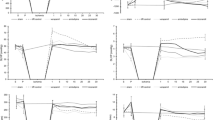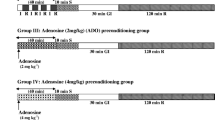Abstract
The mechanism for the suppression of reperfusion arrhythmia by preconditioning (PC) remains unknown. This study aimed to examine the roles of the adenosine receptor, prostaglandin (PG), and bradykinin (BK) receptor in PC. Under pentobarbital anesthesia, the coronary artery of the rat was occluded for 5 min and then reperfused. In untreated controls, this protocol induced ventricular tachycardia (VT) in 100% of the rats and ventricular fibrillation (VF) in 60%. PC with 2 min ischemia/5 min reperfusion prior to the 5 min coronary occlusion significantly reduced the incidence of reperfusion VT and VF to 30% and 0%, respectively. This antiarrhythmic effect of the PC was not blocked when rats were pretreated with 8-phenyltheophylline (8-PT, 10 mg/kg), aspirin-DL-lysin (18 mg/kg), or a specific BK receptor antagonist, Hoe 140 (20 nmol/kg). None of these agents alone significantly modified the incidence of reperfusion VT or VF. These results suggest that neither the adenosine receptor, endogenous PG, nor BK receptor play a major role in the mechanism of suppression of perfusion arrhythmias by PC in the rat heart.
Similar content being viewed by others
References
Belardinelli L, Linden J, Berne RM (1989) The cardiac effects of adenosine. Prog Cardiovasc Dis 32: 73–97
Black SC, Fagbemi O, Chi L, Friedrichs GS, Lucchesi BR (1993) Phorbol esterinduced ventricular fibrillation in the Langendorff-perfused rabbit heart: antagonism by staurosporine and glibenclamide. J Mol Cell Cardiol 25: 1427–1438
Cave AC, Collis CS, Downey JM, Hearse DJ (1993) Improved functional recovery by ischaemic preconditioning is not mediated by adenosine in the globally ischeamic isolated rat heart. Cardiovasc Res 27: 663–668
Fredholm, BB, Hedqvist P (1980) Modulation of neurotransmission by purine nucleosides and nucleotides. Biochem Pharmacol 29: 1635–1643
Goldberg S, Greenspon AJ, Urban PL et al. (1983) Reperfusion arrhythmia: a marker of restoration of antegrade flow during intracoronary thrombolysis for acute myocardial infarction. Am Heart J 105: 26–32
Gross GJ, Auchampach JA (1992) Blockade of ATP-sensitive potassium channel prevents myocardial preconditioning in dogs. Circ Res 70: 223–233
Hagar JM, Hale SL, Kloner RA (1991) Effect of preconditioning ischemia on reperfusion arrhythmias after coronary artery occlusion and reperfusion in the rat. Circ Res 68: 61–68
Hearse DJ (1990) Free radicals, membrane injury, and electrophysiological disorders. In: Zipes DP, Jalife J (ed) Cardiac Electrophysiology: From Cell to Bedside. Philadelphia: Saunders, pp 442–447
Hock FJ, Wirth K, Albus U, Linz W, Gerhards G, Wiemer G, Henke St, Breipohl G, Konig W, Knolle J, Schölkens BA (1991) Hoe 140 a new potent and long acting bradykinin-antagonist: in vitro studies. Br J Pharmacol 102: 769–773
Hoshida S, Kuzuya T, Fuji H et al. (1993) Sublethal ischemia alters myocardial antioxidant activity in canine heart. Am J Physiol 264: H33-H39
Kimura E, Hashimoto K, Furukawa S, Hayakawa H (1973) Changes in bradykinin level in coronary sinus blood after the experimental occlusion of a coronary artery. Am Heart J 85: 635–647
Kida M, Fujiwara H, Ishida M et al. (1991) Ischemic preconditioning preserves creatine phosphate and intracellular pH. Circulation 84: 2495–2503
Kitakaze M, Hori M, Kamada T (1993) Role of adenosine and its interaction with alpha adrenoceptor activity in ischaemic and reperfusion injury of the myocardium. Cardiovasc Res 27: 18–27
Lawson CS, Avikiran M, Shattock MJ, Coltart DJ, Hearse DJ (1993) Preconditioning and reperfusion arrhythmias in the isolated rat heart: true protection or temporal shift in vulnerability? Cardiovase Res 27: 2274–2281
Li Y, Kloner RA (1993) The cardioprotective effects of ischemic preconditioning are not mediated by adenosine receptors in rat hearts. Circulation 87: 1642–1648
Li Y, Kloner RA (1992) Cardioprotective effects of ischaemic preconditioning are not mediated by prostanoids. Cardiovasc Res 26: 226–231
Liu Y, Downey JM (1993) Preconditioning against infarction in the rat heart does not involve a pertussis toxin sensitive G protein. Cardiovasc Res 27: 608–611
Liu Y, Downey JM (1993) Ischemic preconditioning protects rat heart against infarction. Am J Physiol 263: H1107-H1112
Liu GS, Stanley AWH, Downey JM (1992) Cyclooxygenase products are not involved in the protection against myocardial infarction afforded by preconditioning in rabbit. Am J Cardiovasc Pathol 4: 56–63
Liu GS, Thornton J, Van Winkle DM, Stanley AWH, Olsson RA, Downey JM (1991) Protection against infarction afforded by preconditioning is mediated by A1 adenosine receptors in rabbit heart. Circulation 84: 350–356
Manning AS, Hearse DJ (1984) Reperfusion-induced arrhythmias: mechanisms and prevention. J Mol Cell Cardiol 16: 497–518
Martorana PA, Kettenbach B, Breipohl G, Linz W, Schölkens BA (1990) Reduction of infarct size by local angiotensin-converting enzyme inhibition is abolished by a bradykinin antagonist. Eur J Pharmacol 182: 395–396
Matsuki T, Shoji T, Yoshida S et al. (1987) Sympathetically induced myocardial ischaemia causes the heart to release plasma kinin. Cardiovasc Res 21: 428–432
Miura T, Iimura O (1993) Infarct size limitation by preconditioning: its phenomenological features and the key role of adenosine. Cardiovasc Res 27: 36–42
Miura T, Ogawa T, Iwamoto T, Shimamoto K, Iimura O (1992) Dipyridamole potentiates the myocardial infarct size-limiting effect of ischemic preconditioning. Circulation 86: 979–985
Morady F, DiCarlo L, Winston S, Davis JC, Scheinman MM (1984) Clinical features and prognosis of patients with out of hospital cardiac arrest and a normal electrophysiological study. J Am Coll Cardiol 4: 39–44
Murry CE, Richard VJ, Reimer KA, Jennings RB (1990) Ischemic preconditioning slows energy metabolism and delays ultrastructural damage during a sustained ischemic episode. Circ Res 66: 913–931
Patel VC, Woolfson RG, Singh KJ, Neild GH, Yellon DM (1992) Ischemic preconditioning is not prevented by inhibition of endothelium-derived nitric oxide. (Abstract). J Mol Cell Cardiol 24 (suppl I): S 152
Piacentini L, Wainwright CL, Parratt JR (1993) The antiarrhythmic effect of preconditioning, in rat isolated hearts, does not involve A1 adenosine receptors. (Abstract). Br J Pharmacol 107 (suppl): 137P
Richard G, Waas W, Kranzhofer R, Mayer E, Schomig A (1987) Adenosine inhibits exocytotic release of endogenous noradrenaline in rat heart: a protective mechanism in early myocardial ischemia. Circ Res 61: 117–123
Sheehan FH, Epstein SE (1982) Determinants of arrhythmic death due to coronary spasm: Effect of preexisting coronary artery stenosis on the incidence of reperfusion arrhythmia. Circulation 65: 259–264
Sheridan DJ (1987) Reperfusioninduced arrhythmias: An experimental observation awaiting clinical discovery? In: Hearse DJ, Manning AS, Janse MJ (ed) Life-threatening arrhythmias during ischemia and infarction. New York: Raven Press, pp 49–62
Shiki K, Hearse DJ (1987) Preconditioning of ischemic myocardium: reperfusion-induced arrhythmias. Am J Physiol 253: H1470-H1476
Spinelli W, Sorota S, Siegal M, Hoffman BF (1991) Antiarrhythmic actions of the ATP regulated K+ current activated by pinacidil. Circ Res 68: 1127–1137
Thornton JD, Thornton CS, Sterling DL, Downey JM (1993) Blockade of ATP-sensitive potassium channels increases infarct size but does not prevent preconditioning in rabbit hearts. Circ Res 72: 44–49
Vegh A, Szekeres L, Parratt JR (1990) Protective effects of preconditioning of the ischaemic myocardium involve cyclo-oxygenase products. Cardiovasc Res 24: 1020–1023
Vegh A, Szekeres L, Parratt JR (1991) Local intracoronary infusions of bradykinin profoundly reduce the severity of ischaemia-induced arrhythmias in anaesthetised dogs. Br J Pharmacol 1991; 104: 294–295
Vegh A, Szekeres L, Parratt JR (1992) Preconditioning of the ischaemic myocardium: involvment of the L-arginine nitric oxide pathway. Br J Pharmacol 107: 648–652
Walker MJA, Curtis MJ, Hearse DJ, Campbell RWF, et al. (1988) The Lambeth Conventions: guidelines for the study of arrhythmias in ischaemia, infarction, and reperfusion. Cardiovasc Res 2: 447–455
Wirth K, Hock FJ, Albus U, Linz W, Alpermann HG, Anagnostopoulos H, Henke St, Breipohl G, Konig W, Knolle J, Scholkens BA (1991) Hoe 140 a new potent and long acting bradykinin-antagonist: in vivo studies. Br J Pharmacol 102: 774–777
Ytrehus K, Liu Y, Downey JM (1994) Preconditioning protects the ischemic rabbit heart by protein kinase C activation. Am J Physiol: H1145–H1152
Author information
Authors and Affiliations
Rights and permissions
About this article
Cite this article
Miura, T., Ishimoto, R., Sakamoto, J. et al. Suppression of reperfusion arrhythmia by ischemic preconditioning in the rat: Is it mediated by the adenosine receptor, prostaglandin, or bradykinin receptor?. Basic Res Cardiol 90, 240–246 (1995). https://doi.org/10.1007/BF00805667
Received:
Revised:
Accepted:
Issue Date:
DOI: https://doi.org/10.1007/BF00805667




